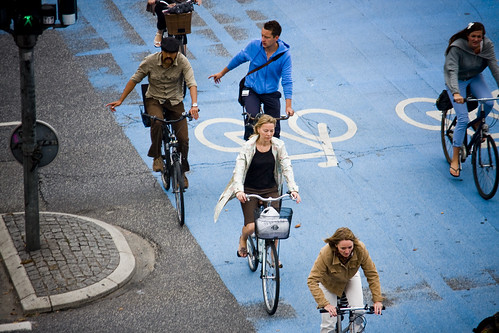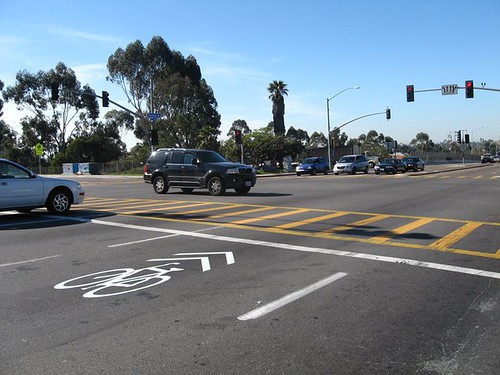SANDAG Releases Draft 2050 Regional Transportation Plan
The Board of Directors at the San Diego Association of Governments (SANDAG) released the 2050 Regional Transportation Plan (RTP) last Friday. The document is available at SANDAG's website. Public hearings and workshops are scheduled to be held in June.
In conjunction with the RTP's release, SANDAG also prepared a video to inform the public about the purpose and goals of the region's transportation plans leading up to 2050.
I have not read the plan yet, but in the video, I was struck by the glaring omission of the utter lack of mention of bicycling as a means to solve all the problems that we as a region are facing and will continue to face in the years ahead. Car pooling, telecommuting, transit use and infield development will certainly go a long way in attaining the region's goals to reduce greenhouse gas emissions. But we as a society are married to the idea of independently transporting ourselves and bicycle can not only take the place of the private automobile, but it can also transform us as a society and make us better able to withstand the realities of dwindling resources and economic downturns. I hope the actual RTP promotes the bicycle as an effective transportation mode.
Does San Diego have a bicycle culture?
A few weeks ago, two students from the University of Copenhagen made their way over to San Diego to study the city's bicycle culture. These women, Sidsel Birk Hjuler and Anne Grethe Pabst, are working on their Masters degree with the thesis covering what a bicycle culture means and how a city can go about attaining it.
They were comparing and contrasting a European city (Barcelona) with an American city (San Diego) to determine if there were tangible characteristics that contributed toward an identifiable bicycle culture. Both cities have a similar climate, a similar sized population and historically have had very low bicycle modal shares, or at least Barcelona did until very recently.
I spent a better part of two weeks with them riding around San Diego showing them what we did have, and what we didn't. And the list of what San Diego didn't have was exceedingly shocking to our Danish visitors. From the lack of continuous bike lanes and the lack of interconnected bike infrastructure to the lack of bicycle parking at destinations they finally began to see why San Diego wasn't quite the bicycling mecca that Copenhagen or Amsterdam is.
The City of San Diego provided Hjuler and Pabst with a forum to present how Copenhagen came to be what it is along with their findings about Barcelona. In both places, the biggest source of change came from a strong political will to change the transportation dynamics.

Copenhagen made a change in transportation policies after the 1973 Oil Crisis by instituting Car Free Sundays which gave its citizens a chance to reconnect with their community outside of an automobile. Then the city continued to create bicycle friendly infrastructure and promote bicycling as a viable, financially savvy mode of transportation. The city is now on track to be carbon-free by 2050.
A more recent example of change can be seen in Barcelona. The city of Barcelona implemented a bicycle sharing service that grew by over 180,000 subscribers in two years. By integrating the bicycle share service with the public transit service, residents now could go further distances by being multi-modal.
Meanwhile, here in San Diego we've got missing bike lanes that then turn into sharrows with no warning or announcement or even fanfare:

Riding up various mesas and into the valley and alongside speeding traffic with no protective barrier, our Danish visitors began to understand why the bicycle modal share in San Diego is so abysmally low. But where there were no bicycle infrastructure to be found, they did find a very warm and welcoming bicycle community.
Both the students were able to take part in the Tweed Ride and wondered why Copenhagen didn't have such a fun activity that involved a dressing up to go on a bicycle ride. During their stay, Both Hjuler and Pabst were able to talk to many planners, advocates, and other movers and shakers in the bicycle community. What they found was that San Diego was indeed in the midst of a change. While San Diego appears to lack the the political will to institute change in its transportation policy, the Danes found many citizens who were taking control to demand change for both themselves and the future citizens of this city. As a city that came of age during the automobile boom, there is much that will change in the coming years to ensure that transportation dollars aren't unfairly being diverted to a single mode of transportation.
With American cities like Portland and New York leading the way in showing what a city of the future looks like, it only makes sense for San Diego to follow suit rather than continuing to subscribe to an old dying transportation paradigm.
SANDAG Staff recommends allocating $2.6 billion toward bicycle and pedestrian infrastructure
The staff at San Diego's regional planning agency, SANDAG, yesterday recommended that the agency allocate $2.6 billion toward bicycle and pedestrian programs during the course of the next 40 years.
At the Committee on Binational Regional Opportunities meeting held yesterday, the 2050 Regional Transportation Plan was on the agenda where the SANDAG staff recommended that the Agency allocate $2.6 billion toward bicycle and pedestrian programs. According to Kathy Keehan, Executive Director at the San Diego County Bicycle Coalition, this translates into $65 million dollars a year being allocated toward bicycle and pedestrian infrastructure. The board is expected to vote on this recommendation this coming Friday. In light of this, Keehan urges residents in the county to call their representatives to support the proposed $2.6 billion recommendation.
Read more
